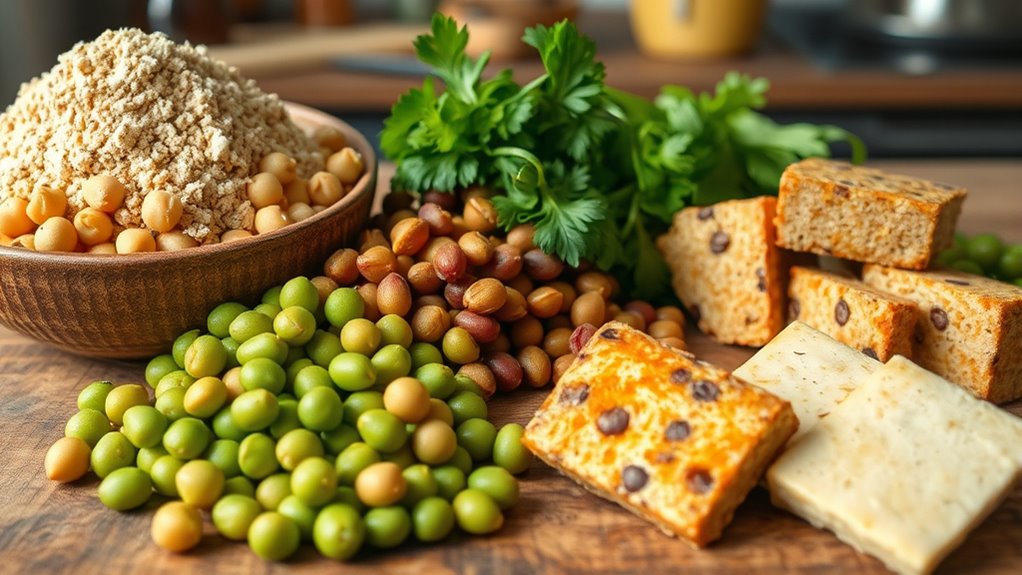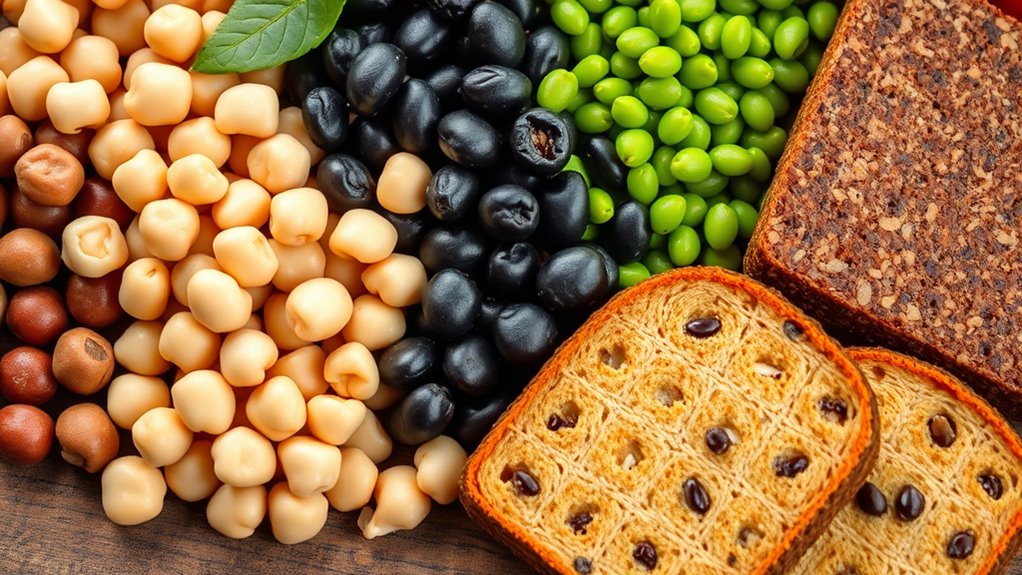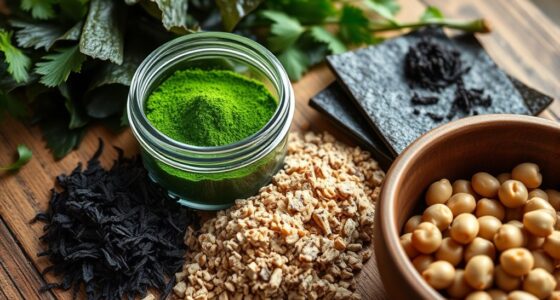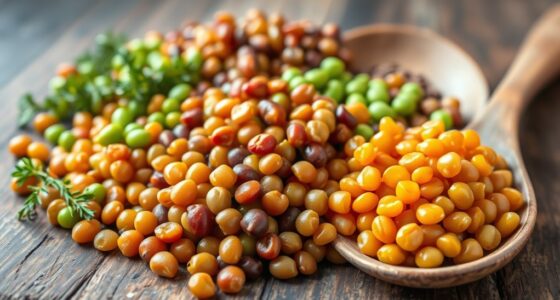Plant-based proteins go well beyond tofu, offering a variety of nutritious options like beans, lentils, chickpeas, and peas, each with unique benefits. These options are sustainable, affordable, and easy to prepare, while also boosting your diet with essential vitamins, minerals, and fiber. Pairing grains with legumes can create complete proteins, making your meals both satisfying and balanced. Keep exploring to discover how these versatile foods can enhance your plant-based diet.
Key Takeaways
- Legumes like beans, lentils, chickpeas, and peas offer diverse, nutrient-rich plant-based protein options beyond tofu.
- Combining grains such as rice, quinoa, or barley with legumes creates complete proteins essential for a balanced diet.
- Legumes are affordable, versatile, and easy to incorporate into various meals like stews, salads, and snacks.
- Plant-based proteins support environmental sustainability and provide health benefits through high fiber and antioxidant content.
- Exploring a variety of plant proteins enhances nutritional intake and adds flavor and texture to plant-based meals.

Plant-based proteins have gained popularity as a sustainable and healthy alternative to animal products, offering numerous benefits for both your body and the environment. While many people are familiar with tofu, there’s a wide world of other options that can provide the protein you need without relying on traditional soy products. Exploring different legume varieties and grain combinations allows you to diversify your diet, maximize nutrient intake, and enjoy a variety of flavors and textures.
Legume varieties are among the most versatile sources of plant protein. Beans, lentils, chickpeas, and peas each bring their own unique nutritional profile and culinary uses. For example, lentils cook quickly and are perfect for soups or salads, while chickpeas can be roasted for snacks or mashed into hummus. Beans like black beans, kidney beans, and pinto beans are rich in fiber and protein, making them ideal for hearty stews or burritos. Incorporating a variety of these legumes not only boosts your protein intake but also ensures you benefit from different vitamins, minerals, and antioxidants. Plus, legumes are generally affordable, widely available, and easy to prepare, making them a practical choice for everyday meals.
Grain combinations play an essential role in creating complete plant-based protein sources. Unlike animal proteins, most plant proteins are incomplete, meaning they lack one or more essential amino acids. However, by combining grains with legumes, you can cover all your amino acid needs. For instance, rice and beans form a classic pairing that delivers a complete protein profile. Quinoa, often considered a pseudo-grain, naturally contains all essential amino acids, making it an excellent standalone source, but it can also be paired with other legumes or vegetables for added variety. Other good grain combinations include barley with lentils, or bulgur with chickpeas. These combinations not only improve the nutritional value but also add texture and flavor to your dishes, making plant-based meals more satisfying and enjoyable.
Frequently Asked Questions
Which Plant Proteins Are Complete Proteins?
You’ll find that soy, quinoa, and buckwheat are complete plant proteins, providing all essential amino acids. Soy isoflavones enhance its health benefits, making it a popular choice. Exploring legume diversity reveals other options like lentils and chickpeas, but they’re typically incomplete proteins. Combining different plant sources helps guarantee you get all amino acids, especially if you’re relying on a variety of legumes and grains in your diet.
How Do Plant-Based Proteins Compare Nutritionally to Animal Proteins?
Plant-based proteins often have lower bioavailability than animal proteins, meaning your body absorbs less of their nutrients. Their amino acid profiles can also differ, sometimes lacking essential amino acids found in animal sources. However, by combining different plant proteins, you can improve their overall nutritional value and achieve a complete amino acid profile. This way, you get comparable nutrition, supporting your health while sticking to plant-based diets.
What Are the Best Plant Protein Sources for Athletes?
Think of plant protein sources for athletes as hidden gems waiting to fuel your performance. Legumes like lentils and chickpeas, quinoa, and hemp seeds pack a punch, offering essential amino acids. Don’t fall for plant protein myths that plant sources are incomplete; vegan protein shakes can complement your diet. Incorporate these powerhouses into your meals, and you’ll harness plant-based strength, breaking barriers and boosting endurance naturally.
Are Plant Proteins Suitable for People With Allergies?
Plant proteins can be suitable for people with allergies if you choose carefully. If you have soy allergies, avoid soy-based products like edamame and certain protein isolates. For nut sensitivities, steer clear of nuts and nut-based proteins like almond or peanut powders. Instead, explore options like peas, lentils, quinoa, or seeds like chia and hemp. Always read labels and consult your doctor to verify the plant protein sources are safe for you.
How Sustainable Are Different Plant-Based Protein Sources?
Did you know that plant-based proteins generally have a 90% lower environmental impact than animal proteins? You’ll find that sources like peas and lentils require less water, land, and energy, thanks to sustainable agricultural practices. This makes them more eco-friendly options. By choosing diverse plant proteins, you support better resource management and reduce your carbon footprint, helping protect the planet for future generations.
Conclusion
So, now that you know there’s more to plant-based proteins than just tofu, isn’t it exciting to explore new options? By trying different sources like lentils, chickpeas, or tempeh, you can diversify your diet and enjoy delicious, nutritious meals. Why settle for the usual when you can discover a whole world of plant-powered possibilities? Embrace these alternatives and make your meals both tasty and sustainable. Are you ready to take the next step?
Ilana has been a vegan for over 10 years. She originally made the switch for health reasons, but soon found herself becoming more and more passionate about the ethical and environmental implications of a vegan lifestyle. Ilana is the author of The Graceful Kitchen, a blog all about veganism. She loves to cook up delicious and nutritious vegan meals, and share her recipes with others who are interested in leading a cruelty-free life. Ilana is also a strong advocate for using whole foods as the foundation of a healthy diet, and believes that going vegan is one of the best ways to achieve this.










